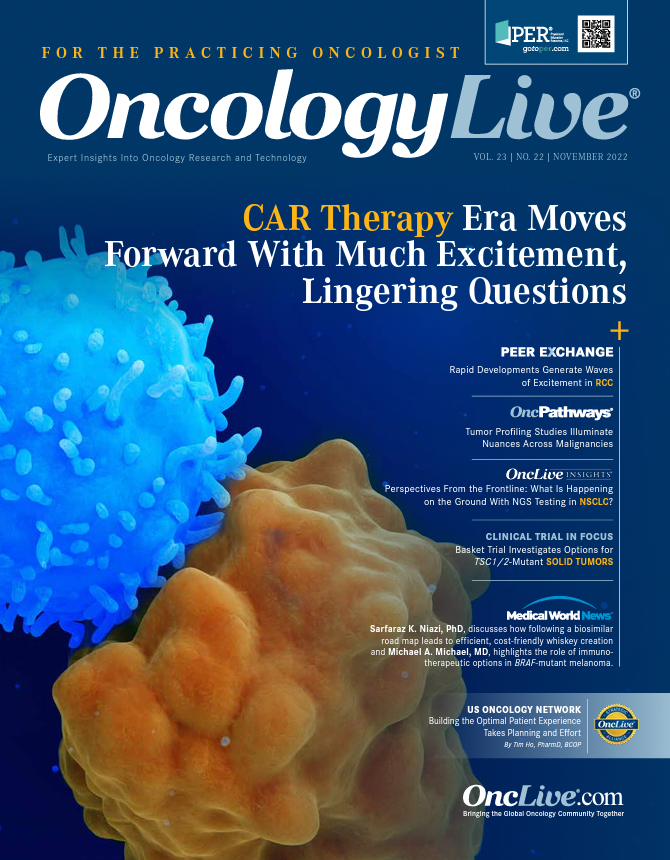Publication
Article
Oncology Live®
Rapid Developments Generate Waves of Excitement for Patients With RCC
Author(s):
A variety of factors must be considered for treatment decisions for patients with renal cell carcinoma due to the expanded number of options available to clinicians.
Benjamin Maughan, MD, PharmD

The treatment paradigm for patients with renal cell carcinoma (RCC) has progressed to the point where clinicians have several options available to them. However, with this optionality, clinicians must consider a variety of factors when selecting the proper treatment regimen for a given patient.
“RCC is one of the more moderate or somewhat less frequent cancers in the US, at least, it is around the ninth-most frequent cancer that we see,” Benjamin Maughan, MD, PharmD, said in a recent OncLive Peer Exchange®. “As with every cancer, there’s a spectrum of biologic activity and therefore prognosis for the patients that we see. The most common clinical criteria that we use are the Memorial Sloan Kettering and the IMDC [International Metastatic RCC Database Consortium] scoring systems. The real bonus or utility of both of those systems is that they use very easy to obtain information, things like hemoglobin, LDH, or the time course of when they became metastatic, and then you are starting systemic therapy.”
A panel of genitourinary cancer experts joined Maughan to discuss the evolving treatment landscape of RCC following the European Society for Medical Oncology (ESMO) Annual Congress 2022. They reviewed first-line therapy options and updated data from novel therapy options across lines in advanced clear cell RCC, and the status of the treatment landscape for patients with nonclear cell RCC.
A Multitude of Options in the First-Line Setting
First-line treatment of patients with advanced clear cell RCC who are not eligible for nephrectomy generally consists of combination therapy, usually using immunotherapies and/or kinase inhibitors. There are multiple FDA-approved combinations in the setting, which combination is the proper one for a given patient depends on a variety of factors including age, comorbidities, risk group, and quality of life considerations. The phase 3 CheckMate 214 trial (NCT02231749) compared the immunotherapy combination of nivolumab (Opdivo) plus ipilimumab (Yervoy) with the kinase inhibitor sunitinib (Sutent), in patients with treatment-naïve, advanced RCC. The primary end points of the study were overall response rate (ORR), overall survival (OS), and progression-free survival (PFS).1
Data from the 5-year follow-up of CheckMate 214 showed that, at a median follow-up of 67.7 months, patients in the intent-to-treat (ITT) population who were treated with the combination (n = 550) experienced a median OS of 56 months vs 38 months among the 546-patients in the ITT who received sunitinib (HR, 0.72; 95% CI, 0.62-0.85). Moreover, the ORR was 39% and 32%, with complete response rates of 12% and 3%, respectively. Investigators also noted that the combination displayed no new safety signals with the longer follow-up.
Ulka Nitin Vaishampayan, MD

“At the 4-year mark, there was about an 11% increase in the number of patients that were still alive after ipilimumab/nivolumab combination as compared to sunitinib,” Ulka Nitin Vaishampayan, MD, said. “[It is] remarkable efficacy. The toxicity has its nuances and careful management is essential. As we have applied that regimen to our average practice it has become tougher and tougher, the incidence of toxicities is higher. They really need to be diligently managed and acted upon quickly. Immediate immunosuppression and careful monitoring of the patients is critical.”
In the phase 3 KEYNOTE-426 trial (NCT02853331), the immunotherapy pembrolizumab (Keytruda) plus axitinib (Inlyta) was compared with sunitinib monotherapy in patients with treatment-naïve advanced clear cell RCC. The dual primary end points were OS and PFS.2
At a median follow-up of 42.8 months (range, 35.6-50.6), patients who received the combination (n = 432) experienced a median OS of 45.7 months compared with 40.1 months among the 429 patients who received sunitinib (HR, 0.73; 95% CI, 0.600.88; P < .001). Additionally, patients in the investigational arm also experienced a benefit in terms of ORR (60.4% vs 39.6%, respectively) and median PFS (15.7 months vs 11.1 months, respectively).
In the phase 3 CLEAR trial (NCT02811861), pembrolizumab was again used, this time in combination with the kinase inhibitor lenvatinib (Lenvima). The combination was compared with sunitinib in patients with advanced clear cell RCC. The primary end point was PFS.3
Patients treated with pembrolizumab and lenvatinib (n = 355) had a median survival follow-up of 33.7 months and patients in the monotherapy arm (n = 357) had a median survival follow-up of 33.4 months. The median PFS was 23.3 months (95% CI, 20.8-27.7) vs 9.2 months (95% CI, 6.0-11.0), respectively (HR, 0.42; 95% CI, 0.34-0.52). Additionally, patients in the investigational arm experienced a significantly higher ORR compared with those in the control arm, 71% (95% CI, 66.3%-75.7%) vs 36.1% (95% CI, 31.2%-41.1%), respectively.
The phase 3 CheckMate 9ER trial (NCT03141177) tested the efficacy of combining an immunotherapy agent with a tyrosine kinase inhibitor (TKI) in RCC. The trial compared nivolumab plus the TKI cabozantinib (Cabometyx) with sunitinib in patients with treatment-naïve clear cell RCC. The primary end point was PFS by blinded independent central review.4
Patients in the combination arm (n = 323) experienced a median PFS of 16.6 months compared with 8.3 months in the sunitinib group (n = 328; HR, 0.56; 95% CI 0.46–0.68). The ORR was 55.7% (95% CI, 50.1%-61.2%) vs 28.4% (95% CI, 23.5%-33.6%), respectively. A median OS improvement was also observed; 37.7 months vs 34.3 months, respectively (HR, 0.70; 95% CI, 0.55-0.90).
“We need to spell out the treatment sequences better,” Vaishampayan said. “All these regimens have been in parallel, and they have all been compared to sunitinib. We really have not had a chance to optimize these regimens as to what happens after front line immunotherapy [plus] immunotherapy versus immunotherapy [plus] TKI. And what are the pros and cons of which way we should go going forward.”
Beyond the currently available options in terms of combination therapies, investigators are vying to fill some of the blind spots in the RCC treatment landscape by evaluating several novel doublet and triplet regimens in the frontline setting. Updated findings from many of these clinical trials were presented during the 2022 ESMO Congress.
In the ongoing phase 2 LITESPARK-003 trial (NCT03634540), investigators are adding the first-in-class HIF-2α belzutifan (Welireg) to cabozantinib for the treatment of patients with advanced clear cell RCC. The primary end point of the trial is confirmed ORR. Secondary end points include duration of response (DOR), PFS, and OS.5
Investigators presented preliminary findings from treatment-naïve patients (cohort 1; n = 35). At a median follow-up of 14 months (range, 0.2-33.0), the confirmed ORR was 57%, including 2 patients who achieved a complete response. Additionally, the median DOR was 28.6 months (range, 1.7+28.6) and the median PFS was 30.3 months (95% CI, 9.4–not reached). Ten patients had to discontinue treatment with the combination, mostly due to progression (n = 8). Belzutifan plus cabozantinib had manageable safety with promising antitumor activity in treatment-naïve patients with advanced clear cell RCC, study authors wrote in a presentation at ESMO Congress 2022.
Eric Jonasch, MD

“At the moment, we do not actually have any good biological rationale necessarily for combining HIF-2α with a TKI or with immunotherapy, but the clinical trials are proceeding,” Eric Jonasch, MD, said. “These wonderful data that we see here; how much of that is driven by belzutifan alone? How much is cabozantinib adding to it? A cautionary note [is needed] as we start just, as oncologists do, piling drugs upon drugs.”
Data from another ongoing study in the first-line RCC space were presented during the 2022 ESMO Congress. The phase 3 PIVOT-09 trial (NCT03729245) is comparing nivolumab plus the IL-2 prodrug bempegaldesleukin with investigator’s choice of VEGF-targeted TKI. The primary end points are ORR and OS.6
Investigators reported results for patients with IMDC intermediate- or poor-risk disease. Patients in the investigational arm (n = 256) experienced an ORR of 23%, including a 2% complete response rate, compared with an ORR of 30.6% in the TKI arm. However, a benefit in terms of median DOR, 16.4 months (95% CI, 10.5-22.7) vs 13.2 (95% CI, 10.6-18.6), respectively. Investigators concluded that the combination did not improve outcomes compared with investigator’s choice of TKI.
During the 2021 American Society of Clinical Oncology Genitourinary Cancers Symposium, investigators outlined their plans for the phase 3 PDIGREE trial (NCT03793166). PDIGREE is an adaptive, randomized trial where patients with untreated RCC will initially receive induction ipilimumab plus nivolumab. Patients with complete responses will then undergo maintenance treatment with nivolumab and those who experience progression will switch to treatment with cabozantinib.7
Excitement Building Beyond the First Line
Treatment options in the second-line and later in advanced clear cell RCC are a bit more limited compared with the frontline setting. In this space, less combinations are used and monotherapy with immunotherapies are more common. Similar to the first line, there are multiple FDA-approved treatment regimens.
“All the success of the frontline therapies has put us in a predicament in second-line because now our standard front line is immunotherapy combination strategies and all of our standard second-line options were all derived from the VEGF-targeted era where people were progressing post VEGF, not necessarily post immunotherapies,” Rana McKay, MD, said. “What we are trying to do right now with the level of data that we have is scrapping together retrospective series. There is very limited prospective data to help guide what is the appropriate strategy in patients that have had post immunotherapy progression. It really is a predicament in the field, and it is an area where we just need a ton of clinical trials to help better define what to do in the second-line space.”
Rana McKay, MD

The phase 3 METEOR trial (NCT01865747) compared cabozantinib monotherapy with everolimus (Afinitor) in patients with advanced RCC after prior antiangiogenic therapy. The primary end point was PFS.10
Patients who received cabozantinib (n = 330) experienced a median OS of 21.4 months compared with 17.1 in the 328-patient everolimus arm (HR, 0.70; 95% CI, 0.58-0.85; P = .0002). The median follow-up was 28 months (range, 25-30). Study authors concluded that cabozantinib significantly improved OS compared with everolimus and that the benefit was consistent following a long-term follow-up.
The TIVO-3 trial (NCT02627963) compared tivozanib sorafenib in patients with relapsed/ refractory RCC. Tivozanib was found to significantly improve PFS compared with sorafenib (HR, 0.672; 95% CI, 0.52-0.87). Additionally, patients in the tivozanib arm (n = 175) experienced a 6-month PFS rate of 49.6% (95% CI, 42%-57%) vs 35.1% (95% CI, 27%-43%) in the sorafenib arm (n = 175).11
In the phase 3 CheckMate 025 trial (NCT01668784), investigators examined nivolumab (n = 410) vs everolimus (n = 411) in patients with previously treated RCC. The median OS was 25.0 months (95% CI, 21.8-not estimable) and 19.6 months (95% CI, 17.6-23.1), respectively. The ORR was 25% and 5%, respectively.12
Findings from a phase 2 trial (NCT01136733) led to the FDA approval of lenvatinib plus everolimus for the treatment of patients with advanced RCC in the second-line and beyond. Results from the trial found that the combination elicited a median PFS of 14.6 months (95% CI, 5.9-20.1) compared with 5.5 months (95% CI, 3.5-7.1) with everolimus alone (HR, 0.40; 95% CI; 0.24-0.68; P = .0005).13
In addition to the already approved therapies, there are multiple trials underway examining regimens in the second-line and beyond of clear cell RCC. The phase 3 CONTACT-03 trial (NCT04338269) is comparing atezolizumab in combination with cabozantinib compared with cabozantinib alone following treatment with an immune checkpoint inhibitor. In another phase 3 trial (NCT04987203) investigators are examining tivozanib in combination with nivolumab vs tivozanib monotherapy after 1 or 2 prior lines of therapy. Finally, in a phase 2 trial (NCT03634540) belzutifan is being added to cabozantinib in patients who have received prior immunotherapy and no more than 2 prior treatments.12-14
Limited Non–Clear Cell RCC Treatment Paradigm Persists
Patients with nonclear cell RCC are a more rare and underserved population who are often excluded from phase 3 trials, and thus their treatment options at this point are somewhat lacking. However, there are still some exciting clinical trials underway looking to expand the treatment paradigm.
The phase 2 KEYNOTE-B61 trial (NCT04704219) is examining the combination of pembrolizumab plus lenvatinib as a first-line treatment for patients with advanced nonclear cell RCC. Preliminary results from the trial presented during the ESMO Congress 2022 showed that patients with a follow-up of at least 24 weeks (n = 82) achieved an ORR of 47.6% (95% CI, 36.4%-58.9%), including 3 complete responses. Additionally, the median DOR was not reached (range, 1.4+-7.2+).15
In another phase 2 study (NCT03635892), cabozantinib plus nivolumab is being evaluated as a potential regimen for patients who underwent 1 or fewer prior systematic therapies besides immune checkpoint inhibitors. Initial f indings showed that efficacy-evaluable patients with papillary, unclassified, or translocation-associated RCC (n = 40) achieved an ORR of 47.5% (95% CI, 31.5%-63.9%) with a median PFS of 12.5 months (95% CI, 6.3-16.4).16
Finally, axitinib plus pembrolizumab is being evaluated as a frontline treatment for patients with non-clear cell RCC in the NEMESIA trial. Preliminary data from 25 patients found that the disease control rate was 86.3%. The median PFS was 10.8 months (95% CI, 1.7-11.5) and 7 patients had their treatment interrupted due to immune-related adverse events.17
“The combination of nivolumab and cabozantinib had activity in the non-clear cell population,” McKay said. “But again, we are left with single-arm phase 2 studies in a population of patients that [is] small. It is not randomized data. As a field, we need to move towards being able to better incorporate these patients into clinical trials and really truly test. Right now, we just do not have that level one evidence to support the immunotherapy combination strategies for the non-clear cell patients.”
The future for these patients is not without prospects, moderator Thomas Powels, MD, noted in his concluding remarks. “Overall, I think the renal cancer space is moving forward nicely and has moved incredibly quickly,” he said. “Now we’re assessing these data and beginning to see some negative trials for the first time. That means perhaps we need to change our direction and as we do, I think the academic community as well as the pharmaceutical industry need to get together and work out where that leads us. My personal opinion of this is the biomarkers are going to turn out to be really important in the future.”
References
- Motzer RJ, McDermott DF, McHenry MB, et al. Conditional survival and 5-year follow-up in CheckMate 214: First-line nivolumab + ipilimumab (N+I) versus sunitinib (S) in advanced renal cell carcinoma (aRCC). Ann Oncol. 2021;32(suppl 5):S685-S687. doi:10.1016/j. annonc.2021.08.057
- Rini BI, Plimack ER, Stus V, et al. Pembrolizumab (pembro) plus axitinib (axi) versus sunitinib as first-line therapy for advanced clear cell renal cell carcinoma (ccRCC): Results from 42-month follow-up of KEYNOTE-426. J Clin Oncol. 2021;39(suppl 15):4500. doi:10.1200/ JCO.2021.39.15_suppl.4500
- Porta CG, Eto M, Motzer RJ, et al. Updated efficacy of lenvatinib (LEN) + pembrolizumab (PEMBRO) vs sunitinib (SUN) in patients (pts) with advanced renal cell carcinoma (aRCC) in the CLEAR study. Ann Oncol. 2022;33(suppl 7):S660-S680. doi:10.1016/annonc/annonc1072
- Powles T, Choueiri TK, Burotto M, et al. Final overall survival analysis and organ-specific target lesion assessments with two-year follow-up in CheckMate 9ER: Nivolumab plus cabozantinib versus sunitinib for patients with advanced renal cell carcinoma. J Clin Oncol. 2022;40(suppl 6):350. doi:10.1200/JCO.2022.40.6_suppl.350
- Choueiri TK, Bauer T, Merchan J, et al. Phase II study of belzutifan plus cabozantinib as first-line treatment of advanced renal cell carcinoma (RCC): Cohort 1 of LITESPARK-003. Ann Oncol. 2022;33(suppl 7):S660-S680. doi:10.1016/annonc/annonc1072
- Tannir N, Formiga MN, Agarwal N, et al. Bempegaldesleukin (BEMPEG) plus nivolumab (NIVO) compared to the investigator’s choice of sunitinib or cabozantinib in previously untreated advanced renal cell carcinoma (RCC): Results from a phase III randomized study (PIVOT-09). Ann Oncol. 2022;33(suppl 7):S808-S669. doi:10.1016/ annonc/annonc1089
- Zhang T, Ballman KV, Dipankar A, et al. PDIGREE: An adaptive phase III trial of PD-inhibitor nivolumab and ipilimumab (IPI-NIVO) with VEGF TKI cabozantinib (CABO) in metastatic untreated renal cell cancer (Alliance A031704). J Clin Oncol. 2021;39(suppl 6). doi:10.1200/ JCO.2021.39.6_suppl.TPS366
- Motzer RJ, Escudier B, Powles T, Scheffold C, Choueiri TK. Long-term follow-up of overall survival for cabozantinib versus everolimus in advanced renal cell carcinoma. Br J Cancer. 2018;118(9):1176-1178. doi:10.1038/s41416-018-0061-6
- Atkins MB, Verzoni E, Escudier B, et al. Long-term PFS from TIVO-3: Tivozanib (TIVO) versus sorafenib (SOR) in relapsed/refractory (R/R) advanced RCC. J Clin Oncol. 2022;40(suppl 6):362. doi:10.1200/ JCO.2022.40.6_suppl.362
- Motzer RJ, Escudier B, McDermott DF, et al. Nivolumab versus Everolimus in Advanced Renal-Cell Carcinoma. N Engl J Med. 2015;373(19):1803-1813. doi:10.1056/NEJMoa1510665
- Motzer RJ, Hutson TE, Glen H, et al. Lenvatinib, everolimus, and the combination in patients with metastatic renal cell carcinoma: a randomised, phase 2, open-label, multicentre trial. Lancet Oncol. 2015;16(15):P1473-1482. doi:10.1016/S1470-2045(15)00290-9
- A Study of Atezolizumab in Combination With Cabozantinib Compared to Cabozantinib Alone in Participants With Advanced Renal Cell Carcinoma After Immune Checkpoint Inhibitor Treatment (CONTACT-03). ClinicalTrials.gov. Updated September 26, 2022. Accessed October 26, 2022. https://clinicaltrials.gov/ct2/show/record/NCT04338269
- Study to Compare Tivozanib in Combination With Nivolumab to Tivozanib Monotherapy in Subjects With Renal Cell Carcinoma. ClinicalTrials. gov. Update August 11, 2022. Accessed October 26, 2022. https:// clinicaltrials.gov/ct2/show/record/NCT04987203
- A Trial of Belzutifan (PT2977, MK-6482) in Combination With Cabozantinib in Patients With Clear Cell Renal Cell Carcinoma (ccRCC) (MK-6482-003). ClinicalTrials.gov. Updated August 8, 2022. Accessed October 26, 2022. https://clinicaltrials.gov/ct2/show/record/ NCT03634540
- Albiges L, Gurney HP, Atduev V, et al. Phase II KEYNOTE-B61 study of pembrolizumab (Pembro) + lenvatinib (Lenva) as first-line treatment for non-clear cell renal cell carcinoma (nccRCC). Ann Oncol. 2022;33(suppl 7):S660-S680. doi:10.1016/annonc/annonc1072
- Lee CH, Voss MH, Carlo MI, et al. Phase II trial of cabozantinib plus nivolumab in patients with non–clear-cell renal cell carcinoma and genomic correlates. J Clin Oncol. 2021;40(21):2333-2341. doi:10.1200/ JCO.21.01944
- Stellato M, Buti S, Maruzzo M, et al. Clinical outcome of patients with non-clear metastatic renal cell carcinoma treated with pembrolizumab-axitinib combination: NEMESIA (non-clear metastatic renal cell carcinoma pembrolizumab axitinib) study, a subgroup analysis of I-RARE observational study (Meet-URO 23a). Ann Oncol. 2022;33(suppl 7):S660-S680. doi:10.1016/annonc/annonc1072










